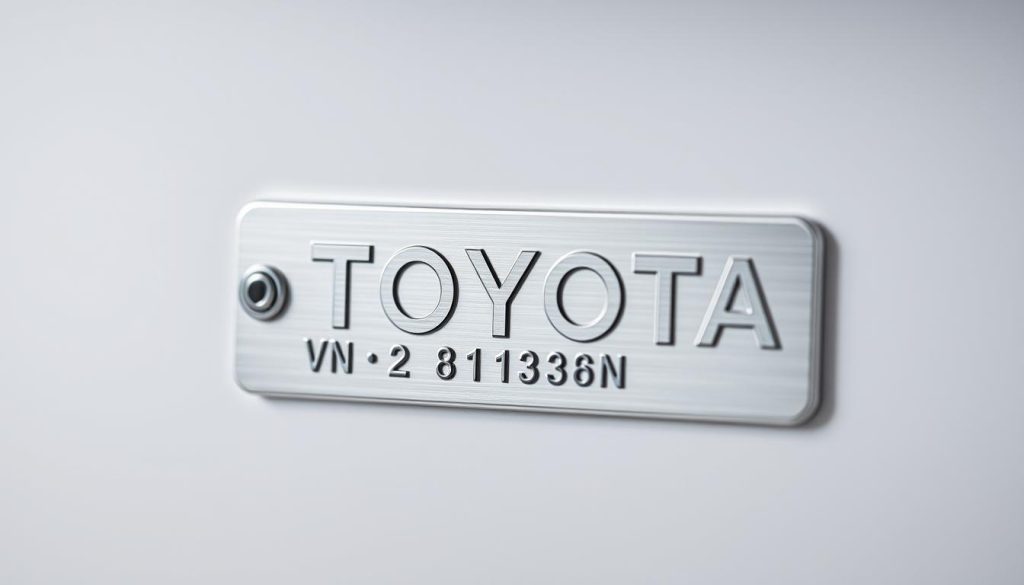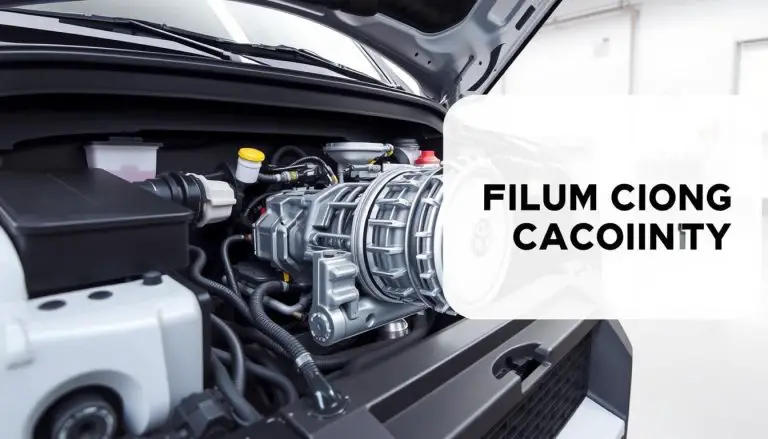The task of deciphering the codes on your vehicle can be a formidable challenge. Toyota’s model numbers and badges encapsulate critical information regarding the car’s specifications, features, and capabilities.
For owners and enthusiasts alike, grasping these identifiers is paramount. They offer profound insights into the vehicle’s lineage, trim level, and technological progressions.
Key Takeaways
- Toyota’s model numbers and badges contain vital information about the vehicle.
- Decoding these identifiers can reveal details about the car’s specifications and features.
- Understanding these codes is essential for owners and enthusiasts.
- Model numbers and badges provide insights into the vehicle’s history and trim level.
- Knowledge of these codes can enhance the ownership experience.
The Secret Language of Toyota Vehicles
Toyota’s model numbers and badges transcend mere alphanumeric sequences; they serve as gateways to deciphering a vehicle’s intricate specifications and attributes.
These enigmatic codes and badges, far from being mere identifiers, unveil a wealth of information regarding a vehicle’s capabilities, engine configuration, and trim level.
Why Toyota Uses Coded Model Numbers
The implementation of coded model numbers by Toyota is a strategic maneuver aimed at efficiently categorizing and identifying its extensive vehicle lineup. This methodology facilitates the management of production, inventory, and sales across diverse markets.
These coded model numbers also play a pivotal role in conveying specific vehicle attributes to both customers and dealerships, thus streamlining the process of matching vehicles with customer preferences.
The Evolution of Toyota’s Naming System
Toyota’s naming system has undergone significant transformations over the years, adapting to the introduction of new models, technological advancements, and shifting market trends. The company’s coding system has been refined to encompass hybrid and electric vehicles, mirroring the dynamic evolution of the automotive industry.
This metamorphosis is evident in the introduction of novel badges and model designations, which signify technological progress and alterations in vehicle specifications.

| Model Code | Vehicle Type | Engine Type |
|---|---|---|
| ACV30 | Toyota Camry | 2.4L 4-Cylinder |
| XLE | Toyota Avalon | 3.5L V6 |
| ZVW30 | Toyota Prius | 1.8L Hybrid |
Breaking Down the Toyota VIN Number
The Toyota VIN number serves as a gateway to your vehicle’s historical and technical data. A Vehicle Identification Number (VIN) is a 17-character code, uniquely assigned to each vehicle. It encapsulates information on its manufacture, model, and equipment, providing a comprehensive identity.

World Manufacturer Identifier Explained
The initial three characters of the VIN are designated as the World Manufacturer Identifier (WMI). This segment discloses the vehicle’s country of origin, manufacturer, and type. For Toyota vehicles produced in Japan, the WMI typically commences with “JTH” or “JTJ.” Grasping the WMI is imperative for tracing the vehicle’s lineage and affirming its legitimacy.
Vehicle Descriptor Section
The subsequent six characters (positions 4-9) constitute the Vehicle Descriptor Section (VDS). This segment elucidates the vehicle’s model, engine type, and other pivotal specifications. It delineates whether the vehicle is a sedan, SUV, or truck, and specifies the engine size and type. The VDS is indispensable for identifying the correct parts and accessories for your Toyota.
Vehicle Identifier Section
The final eight characters (positions 10-17) comprise the Vehicle Identifier Section (VIS). This section is bifurcated into two parts: the first character (position 10) signifies the model year, and the subsequent seven characters represent a unique sequence number for the vehicle. The VIS is crucial for ascertaining the vehicle’s age and production sequence, which is beneficial for maintenance and historical purposes.
“Decoding your Toyota’s VIN number is akin to unlocking a treasure trove of information about your vehicle.” By deciphering the VIN’s various sections, one can acquire profound insights into the vehicle’s history, specifications, and identity.
Decoding Toyota Model Designations
The intricacies of Toyota’s model designation system offer a profound enhancement to the car-buying process, providing a clear insight into the vehicle’s trim, features, and performance capabilities. This system, comprising a blend of letters and numbers, serves as a conduit for conveying specific details about the vehicle in question.
Letter Prefixes and Their Meanings
The initial letters in Toyota’s model designations frequently denote the vehicle’s category or class. For instance, certain prefixes may indicate a sedan, SUV, or truck. The presence of “X” signifies a crossover, while “L” denotes a sedan or wagon. Grasping these prefixes is essential for swiftly identifying the vehicle’s category.
The Toyota RAV4, for example, is identified by the prefix as a compact SUV, contrasting with the Corolla, which is designated as a compact sedan. These prefixes serve as the foundational step in deciphering the model’s inherent characteristics.
Number Sequences Explained
The numerical sequences that follow the letter prefixes in Toyota’s model designations generally represent the vehicle’s generation or model year. These numbers can also signify the engine size or type, and occasionally, the trim level. A higher number often indicates a more advanced or premium version of the model.
| Model | Prefix Meaning | Number Sequence Meaning |
|---|---|---|
| RAV4 | Compact SUV | Generation/Model Year |
| Corolla | Compact Sedan | Generation/Model Year |
| 86 | Sports Coupe | Engine Size/Type |
By comprehending both the letter prefixes and the numerical sequences, buyers and enthusiasts can attain a more profound understanding of Toyota’s model offerings. This knowledge facilitates easier model comparisons, enabling the selection of the most suitable vehicle for individual needs.
Toyota Engine Codes Demystified
Toyota engine codes function as a distinctive identifier for your vehicle’s engine, offering insights into its performance and attributes. Grasping these codes facilitates informed decisions regarding maintenance, enhancements, and the acquisition of a new vehicle.
Understanding the Engine Series
The engine series is a pivotal element within Toyota’s engine coding framework. It delineates the engine family and generation, revealing its design and capabilities. For example, the 2AZ-FE engine, a member of the AZ series, signifies a particular array of features and technological advancements.
Displacement and Configuration Indicators
Engine displacement and configuration are paramount for comprehending an engine’s performance. Toyota’s coding system incorporates indicators for these elements. For instance, in the code 1GR-FE, “GR” signifies the engine series, while the preceding numeral denotes the engine’s displacement.
Special Engine Designations
Toyota employs special designations to underscore unique engine attributes or technological innovations. For example, “FE” in engine codes frequently denotes a fuel-efficient engine variant. Recognizing these designations enables the identification of your vehicle’s engine’s specific characteristics.
| Engine Code Component | Description | Example |
|---|---|---|
| Engine Series | Identifies the engine family | AZ, GR |
| Displacement Indicators | Indicates engine displacement | 1 (small), 2 (medium) |
| Special Designations | Highlights unique features or technologies | FE (Fuel Efficient) |
Understand Your Toyota: Badge Hierarchy Explained
Deciphering Toyota’s badge hierarchy is crucial for unlocking the full potential of their vehicles. The badge system is designed to convey different levels of features, performance, and luxury across their model lineup. This system is pivotal in understanding the nuances of each model.
The badge hierarchy is broadly categorized into entry-level, premium, and special edition badges. Each category signifies a distinct set of characteristics and features. These cater to different customer preferences and needs, ensuring a tailored driving experience.
Entry-Level vs. Premium Badges
Entry-level badges denote the base model or the most affordable version of a Toyota vehicle. These badges are often associated with standard features and less powerful engine options. In contrast, premium badges signify higher trim levels with additional features, upgraded materials, and sometimes more powerful engines.
| Badge Type | Features | Target Audience |
|---|---|---|
| Entry-Level | Standard features, less powerful engines | Budget-conscious buyers |
| Premium | Additional features, upgraded materials, more powerful engines | Buyers seeking luxury and performance |
Special Edition Badges and Their Significance
Special edition badges denote unique or limited-production versions of Toyota models. These badges often signify exclusive features, unique styling elements, or enhanced performance capabilities. They can also commemorate special events or milestones in Toyota’s history.
Special edition badges are highly sought after by collectors and enthusiasts. This is due to their exclusivity and unique characteristics. Examples include the TRD Pro series, designed for off-road enthusiasts, and other limited-edition models with distinct styling and performance upgrades.
Understanding the differences between these badges is essential for making informed decisions when purchasing a Toyota vehicle. Whether you’re looking for a basic, feature-rich, or high-performance model, Toyota’s badge hierarchy provides a clear guide. It helps navigate their diverse lineup effectively.
Toyota’s Trim Level Indicators
Toyota’s trim levels transcend mere nomenclature, embodying a spectrum of functionalities and attributes that profoundly influence the driving experience. In the quest for a Toyota, grasping the nuances of the various trim levels is paramount. It is crucial for identifying the model that aligns with your specific requirements.
LE, XLE, SE, and XSE Explained
The foundational model for numerous Toyota vehicles is the LE trim, striking a harmonious balance between affordability and feature-richness. The XLE trim, on the other hand, enhances comfort and convenience, garnering considerable appeal among consumers. For those desiring a more dynamic aesthetic, the SE trim offers a distinctive styling approach. The XSE trim, by contrast, merges the sporty essence of the SE with an array of premium enhancements.
Limited and Platinum Designations
At the apex of the Toyota hierarchy, the Limited and Platinum trims stand out. The Limited trim is crafted to deliver a sumptuous driving experience, replete with high-end materials and cutting-edge features. The Platinum trim, in turn, elevates this luxury further, often incorporating exclusive features and refinements that solidify its status as the pinnacle of Toyota’s offerings.
By comprehending these trim levels, one can more effectively navigate the Toyota range. This understanding facilitates the identification of the vehicle that most aptly complements one’s lifestyle and preferences.
Performance Badges: TRD, GR, and More
Toyota employs distinct badges to signify its high-performance models, highlighting enhanced capabilities and a lineage to its racing heritage. The TRD (Toyota Racing Development) and GR (Gazoo Racing) badges stand out as pivotal in Toyota’s performance spectrum.
Toyota Racing Development (TRD) Variants
TRD, Toyota’s internal tuning and racing arm, is responsible for crafting high-performance components and vehicles. TRD variants are engineered to elevate performance, handling, and aerodynamics. These vehicles boast upgraded suspension, engines, and brakes, positioning them as more track-ready than their standard counterparts.
The TRD emblem adorns a variety of Toyota models, including the 86, Tacoma, and Tundra. Each TRD model is meticulously crafted to offer a distinct driving experience, encompassing enhancements from cosmetic touches to substantial mechanical upgrades.
Gazoo Racing (GR) and Its Significance
Gazoo Racing (GR) embodies Toyota’s unwavering commitment to performance and motorsports. GR serves as the umbrella under which Toyota markets its most performance-focused vehicles. The GR badge is synonymous with models such as the GR Supra, GR 86, and GR Corolla, engineered to deliver unparalleled driving dynamics and performance.
| Badge | Model Examples | Key Features |
|---|---|---|
| TRD | 86, Tacoma, Tundra | Performance parts, upgraded suspension, aerodynamics |
| GR | GR Supra, GR 86, GR Corolla | High-performance engines, sport-tuned suspension, unique styling |
The TRD and GR badges underscore Toyota’s unwavering commitment to crafting vehicles that excel on the road and honor the brand’s racing legacy.
Hybrid and Electric Vehicle Designations
Toyota’s expansion into the electrified vehicle market necessitates a grasp of the various designations for hybrid and electric vehicles. The badges and naming conventions employed by Toyota serve as indicators of the technology and capabilities of their vehicles. This understanding is paramount for consumers navigating the evolving landscape of Toyota’s electrified offerings.
The Meaning Behind “Hybrid Synergy Drive”
The Hybrid Synergy Drive technology, integral to Toyota’s hybrid vehicles, represents a powertrain that integrates a conventional internal combustion engine with an electric motor. This integration enhances fuel efficiency, diminishes emissions, and offers a more refined driving experience. It embodies the synergy between conventional and electric power sources, optimizing performance and efficiency.
Prime, BEV, and FCEV Badges
Toyota employs distinct badges to differentiate its electrified vehicle offerings. The Prime badge is reserved for plug-in hybrid models, highlighting their capability to operate solely on electric power for a considerable distance. BEV signifies Battery Electric Vehicles, powered exclusively by a battery and electric motor. FCEV denotes Fuel Cell Electric Vehicles, which generate electricity through a chemical reaction between hydrogen and oxygen. These badges are critical for consumers seeking to identify the specific characteristics of Toyota’s electrified vehicles.
Future Electric Vehicle Naming Conventions
As Toyota advances its electric vehicle lineup, new naming conventions are being introduced. The beyond Zero (bZ) series marks a significant milestone in Toyota’s electric vehicle strategy. Familiarity with these designations is essential for consumers aiming to explore Toyota’s expanding range of electrified models.
Toyota vs. Competitors: Naming Conventions Compared
The intricacies of Toyota’s naming conventions have captivated the attention of automotive aficionados, prompting a comparative analysis with its competitors. The automotive sector is characterized by a plethora of naming systems, each embodying distinct logics and histories. Grasping these nuances is imperative for both consumers and industry insiders.
How Toyota Differs from Japanese Rivals
Toyota’s Japanese counterparts, including Honda and Nissan, exhibit distinct naming methodologies. Honda integrates letters and numbers to signify model generations and trim levels. In contrast, Nissan adopts a more simplistic approach, often employing designations such as “S” or “SV” to denote trim levels. Toyota, conversely, employs a more intricate system, utilizing a variety of letters and numbers to convey detailed specifications about the vehicle.
Akio Toyoda, Toyota’s president, elucidated, “Our naming conventions are crafted to encapsulate the essence of our brand and the values we uphold.” This philosophy is evident in Toyota’s utilization of codes to signify disparate models, engine configurations, and trim levels.
Comparing with American and European Systems
Significant disparities emerge when Toyota’s naming conventions are juxtaposed with those of American and European manufacturers. American brands, such as Ford and Chevrolet, favor straightforward naming systems, often employing simple designations like “XL” or “LT” to denote trim levels. In contrast, European manufacturers, including BMW and Mercedes-Benz, employ a combination of letters and numbers to signify model series and engine types. For instance, BMW’s “3 Series” designation is emblematic of a specific model line.
In summary, while Toyota’s naming conventions may appear complex, they provide a level of specificity that is highly valued by consumers and enthusiasts. By examining how Toyota’s system contrasts with that of its competitors, we can develop a deeper understanding of the automotive industry’s complexities.
Recent Changes in Toyota’s Naming Strategy
The automotive sector’s transition towards electrification has prompted Toyota to revise its naming conventions. This evolution in vehicle nomenclature is a direct response to the imperative of distinguishing between diverse models and technologies. Such a shift underscores Toyota’s commitment to innovation and customer clarity.
The Beyond Zero (bZ) Naming Convention
The advent of the Beyond Zero (bZ) naming convention marks a pivotal moment for Toyota’s electric vehicle lineup. This series embodies Toyota’s pledge to a zero-emission future, diverging from traditional naming paradigms. It signifies a focus on sustainability and cutting-edge technology, resonating with the brand’s ethos.
The bZ series is integral to Toyota’s electrification strategy, offering a clear signal to consumers of the brand’s trajectory towards eco-friendly options. This development is a testament to Toyota’s foresight and dedication to environmental stewardship.
Crown Sub-Brand Expansion
The Crown sub-brand’s expansion is another significant development in Toyota’s naming strategy. Traditionally linked with luxury, the Crown badge now adorns a broader spectrum of vehicles. This expansion signifies Toyota’s ambition to elevate its brand portfolio, catering to a diverse array of consumer preferences.
| Naming Convention | Description |
|---|---|
| Beyond Zero (bZ) | Series for electric vehicles, signifying zero-emission technology |
| Crown Sub-Brand | Luxury and premium models, indicating high-end quality and features |
These adjustments reflect Toyota’s proactive stance in adapting its naming strategy to align with industry trends and consumer preferences. This approach underscores Toyota’s commitment to innovation and customer satisfaction.
Practical Benefits of Understanding Toyota Codes
Deciphering Toyota’s coding system can profoundly elevate your vehicle ownership experience. This expertise allows owners and prospective buyers to uncover crucial details about their vehicle’s specifications, capabilities, and historical background. Such knowledge is invaluable, spanning from the initial purchase to ongoing maintenance and parts acquisition.
This insight is pivotal in multiple facets of vehicle ownership, notably in the realms of purchasing and maintenance. We shall dissect two critical domains where grasping Toyota codes offers substantial advantages.
Making Informed Purchase Decisions
Acquiring a Toyota necessitates a thorough understanding of the codes linked to various models. This comprehension empowers buyers to make decisions based on more than superficial characteristics. For example, engine codes unveil critical performance and fuel efficiency metrics. Concurrently, deciphering trim level indicators facilitates the identification of the vehicle’s included features and options.
| Code | Description | Benefit |
|---|---|---|
| Engine Code | Reveals engine specifications | Informed decision on performance and efficiency |
| Trim Level Indicator | Shows included features and options | Helps in choosing the right trim for your needs |
Simplifying Maintenance and Parts Sourcing
Grasping Toyota’s coding system also streamlines maintenance and parts procurement. By identifying your vehicle’s model and engine codes, you can accurately pinpoint the correct parts and specifications for upkeep and repairs. This approach not only saves time but also minimizes the risk of installing incorrect components.
Toyota aficionados universally agree that “Knowing your Toyota’s codes is akin to possessing a key to a more efficient and gratifying ownership experience.” This knowledge empowers you to proactively manage your vehicle’s maintenance and enhancements.
“The more you know about your Toyota’s codes, the more empowered you’ll be to make informed decisions about your vehicle.”
Conclusion: Navigating the World of Toyota with Confidence
The intricacies of Toyota’s naming conventions and badge hierarchy present a formidable challenge. Yet, armed with the insights from this discourse, you are now poised to traverse the Toyota domain with assurance. Mastery over Toyota’s model numbers, engine codes, and trim level indicators empowers you to make discerning choices in both acquisition and maintenance of your vehicle.
With an enhanced comprehension of Toyota’s nomenclature, you will appreciate the distinct attributes and functionalities of each model. This understanding is invaluable, whether you are a seasoned Toyota proprietor or a prospective buyer. It equips you to confidently navigate the extensive Toyota model and trim level spectrum, ensuring the selection of a vehicle that aligns with your specific requirements.
Applying your acquired knowledge of Toyota’s codes and badges streamlines the maintenance and enhancement of your vehicle, enriching your overall ownership experience. As you continue to explore the Toyota realm, your expertise will serve as a guiding force, facilitating informed decisions and maximizing the potential of your vehicle.
FAQ
What do Toyota’s model numbers represent?
Toyota’s model numbers are a composite of letters and numbers, serving as identifiers for specific models. They often denote the vehicle’s size, engine type, and various features.
How do I decode a Toyota VIN number?
To decode a Toyota VIN, one must dissect the 17-character code into segments. These segments reveal the manufacturer, model, engine type, and other critical details.
What is the significance of Toyota’s letter prefixes in model designations?
Toyota’s letter prefixes signify the vehicle’s series, body style, or engine type. This distinction aids in differentiating between models and trim levels.
What do Toyota’s engine codes signify?
Toyota’s engine codes convey information about the engine’s series, displacement, and configuration. They enable owners and technicians to accurately identify the engine specifications.
How do Toyota’s trim level indicators work?
Toyota’s trim level indicators, such as LE, XLE, and TRD, denote the level of features, performance, and luxury associated with a particular vehicle.
What is the difference between Toyota’s TRD and GR performance badges?
TRD (Toyota Racing Development) and GR (Gazoo Racing) badges signify enhanced performance capabilities. TRD focuses on racing-inspired upgrades, while GR represents Toyota’s high-performance division.
What do Toyota’s hybrid and electric vehicle designations mean?
Toyota’s hybrid and electric vehicle designations, such as Hybrid Synergy Drive and Prime, indicate the vehicle’s powertrain configuration and electric capabilities.
How does Toyota’s naming convention compare to its competitors?
Toyota’s naming convention is distinct from its competitors. It emphasizes a combination of letters and numbers to convey specific information about the vehicle.
What are the practical benefits of understanding Toyota’s codes and naming conventions?
Grasping Toyota’s codes and naming conventions facilitates informed purchase decisions. It simplifies maintenance and parts sourcing, enhancing overall confidence in navigating the Toyota universe.
How has Toyota’s naming strategy evolved in recent years?
Toyota has introduced new naming conventions, such as the Beyond Zero (bZ) series for electric vehicles. It has also expanded its Crown sub-brand, reflecting a shift towards electrification and premium offerings.


